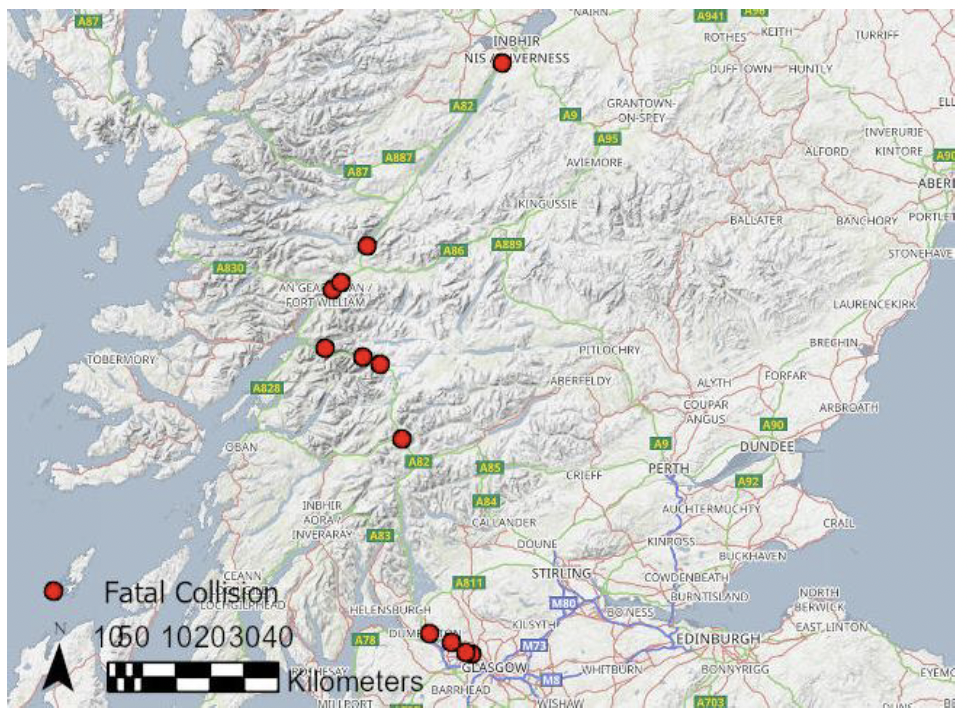5. Countermeasures
5. Countermeasures
Countermeasures (CMs) are pivotal in the prevention of fatal collisions. For the purposes of this research, CMs were identified that if implemented at any stage of the collision (pre, post or during), were assessed to have an impact on the outcome: either stopping the collision from occurring at all or reducing the severity of injuries sustained.
Figure 37 shows how countermeasures can alter the risks that road users are exposed to.
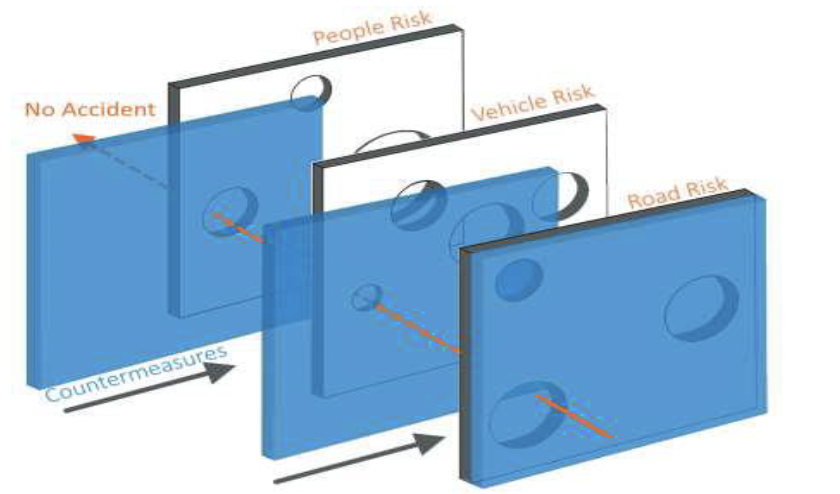
The majority of collisions involved contributory factors relating solely to ‘People’, as highlighted throughout this report. However, analysis of CMs found that less than 1% of collisions would have been prevented or had injury severity reduced by solely ‘People’ countermeasures.
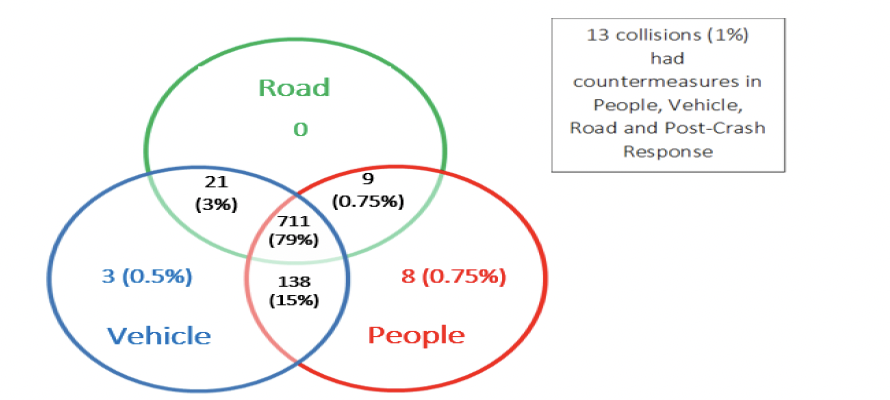
The majority (79%) of collisions may have been influenced by a combination of all three CMs, ‘People’, ‘Vehicle’ and ‘Road’.
98% (n=886 of 903) of all fatal collisions had CMs relating to ‘Vehicle’. This highlights that vehicle safety, design and maintenance are imperative in the reduction of fatal collisions.
As this report includes data from 2015 – 2020, it is noted some countermeasures may now be both mandatory and standard in the fleet, for example Electronic Stability Control (ESC). However, countermeasures were assigned as relevant to the circumstances at the time of the collision.
Figure 39 shows the proportion of countermeasures assigned to fatal collisions. CMs relating to ‘Vehicle’ were the most prevalent, closely followed by ‘People’ CM’s.

2 CMs did not fit the characters of ‘People’, ‘Road’ or ‘Vehicle’ and were identified as ‘Post-crash Response’. These refer to countermeasures where it is deemed that, had emergency services been able to attend the scene sooner, the outcome of the collision may have been altered. They were relevant for 13 fatal collisions.
5.1 Safe System Pillars
Figure 40 shows the number of fatal collisions that had countermeasures in each of the five Safe System pillars. These pillars contribute to a Safe System which takes a holistic approach to road safety and requires those who manage and design the roads and those who use them to take responsibility for, and contribute to, eradicating fatal and serious injuries.
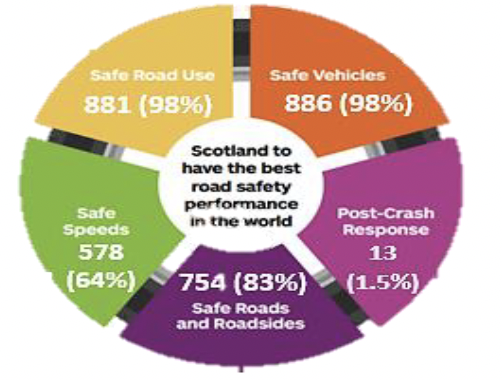
There were some countermeasures which were deemed to align with more than one pillar of the Safe System, for example ‘Add speed camera’ aligns with both ‘Safer Speeds’ and ‘Safer Roads and Roadsides’.
Almost all collisions (98%) had countermeasures relating to Safer Vehicles (n=886) and Safer Road Use (n=881).
This supports the need for vehicles on Scotland’s roads to be as safe as possible in terms of maintenance, design, technology and safety systems. There is also a need to ensure drivers and other road users are able to utilise the road safely, efficiently and sustainably.
5.2 Countermeasure Assessment
It is worth considering countermeasures (CM) separately in terms of both collision avoidance and severity reduction.
A countermeasure may be given a low/not applicable confidence score for collision avoidance but may be given a high score for severity reduction.
For example, the use of a seatbelt would not apply to collision avoidance, but it may be crucial in reducing the severity of injuries sustained and ultimately preventing the fatality.
In total, 7,156 countermeasures were assigned to the 903 fatal collisions.
Of these
- 3,105 (43%) related to vehicles
- 2,493 (35%) related to people
- 1,545 (22%) related to roads
- 13 (<1%) related to post-crash response
(Recommendation 71)
The following figures show the frequency and confidence scores of the most commonly assigned countermeasures for both collision avoidance and severity reduction. Confidence rating is from 1 to 4[66].
The countermeasures are displayed in order of frequency and the coloured bars represent confidence scores. Notable exceptions which were assigned in fewer numbers are also highlighted. Full details of the frequency and confidence scores of countermeasures can be found in appendices D-F.
People’ Countermeasures – Collision Avoidance
Analysis of ‘People’ CMs show that while ‘Training to improve hazard perception skill’ was the most frequently assigned countermeasure for collision avoidance, the confidence level was generally low.
Conversely, more specific countermeasures such as ‘Enhanced banksman training’ and ‘Training for vehicle loading’ had very high confidence levels but were applied less frequently.
Overall, 34% of ‘People’ countermeasures were given a confidence score of 2 (likely) or higher, accounting for 772 of 2,238 CMs assigned for Collision avoidance.
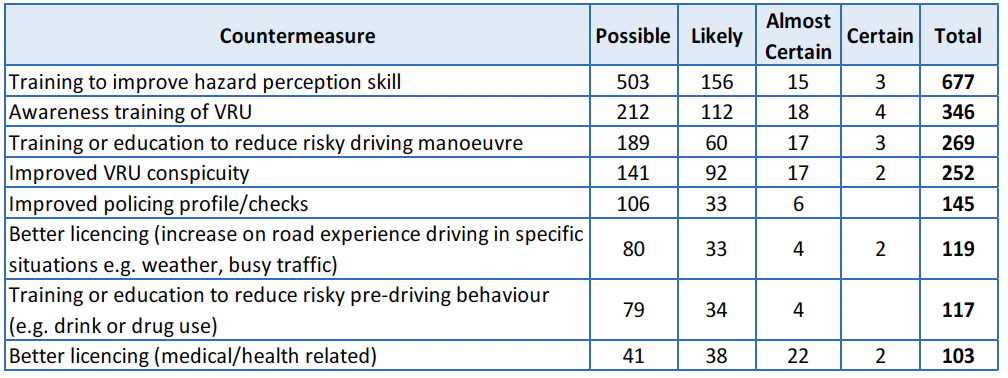
People’ Countermeasures – Severity Reduction
‘Use of seatbelt’ was the most frequently applied ‘People’ countermeasure for severity reduction and in 41% of collisions (n=40 of 98) it was given a confidence rating of 3 or 4.
The positive impact that ‘Proper use of a helmet’ could have on fatalities is also evident with 19% (n=6 of 31) given a confidence score of 3 and a further 56% (n=18) a score of 2. This countermeasure was applicable to pedal cyclists, motorcyclists and quad bike riders.
‘Better licencing (medical/health related)’ and ‘Awareness training of VRU’ were applied much less frequently, however, had high confidence scores indicating that they may be effective countermeasures in reducing fatalities, albeit in a smaller numbers of collisions.
Overall, 44% (n=156 of 356) of People countermeasures for severity reduction were given a confidence score of 2 or more.

Vehicle’ Countermeasures – Collision Avoidance
AEBS was the most frequently assigned countermeasure for collision avoidance with 45% (n=152 of 344) given a confidence score of 2 or more.
84% of collisions (n=57 of 68) where ‘Alco-lock’ was a relevant countermeasure, a confidence score of 4 was assigned for collision avoidance. This countermeasure is deemed to be highly effective in preventing fatalities where alcohol impairment was a contributory factor. Overall, 29% of ‘Vehicle’ countermeasures for collision avoidance were given a confidence score of 2 or more (n=657 of 2,259).
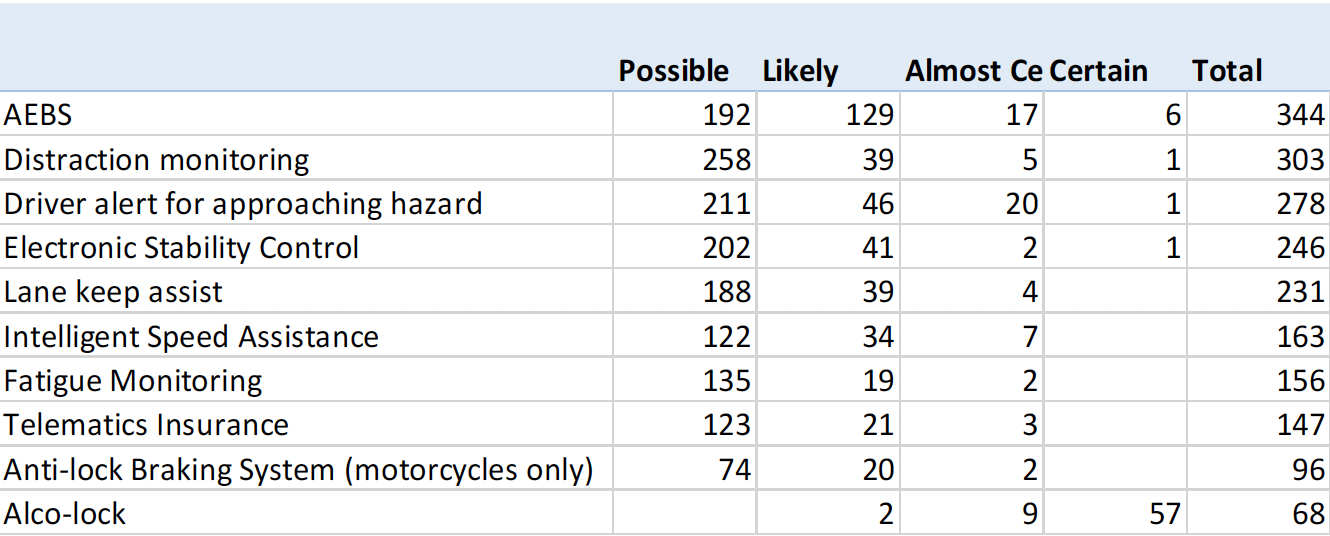
Vehicle’ Countermeasures – Severity Reduction
Vehicle CMs were not given high confidence scores for severity reduction with only 12% (n=194 of 1,143) given a confidence score of 2 or more.
Vehicle CMs would appear to be more significant in collision avoidance.
The vehicle countermeasures with the highest confidence scores were ‘Driver alert for approaching hazard’, ‘AEBS’, ‘Improved rear underrun guards’, ‘Post impact braking system’, ‘Intersection Assistance’ and ‘eCall’.
However, the majority of these are assigned in low numbers of collisions.
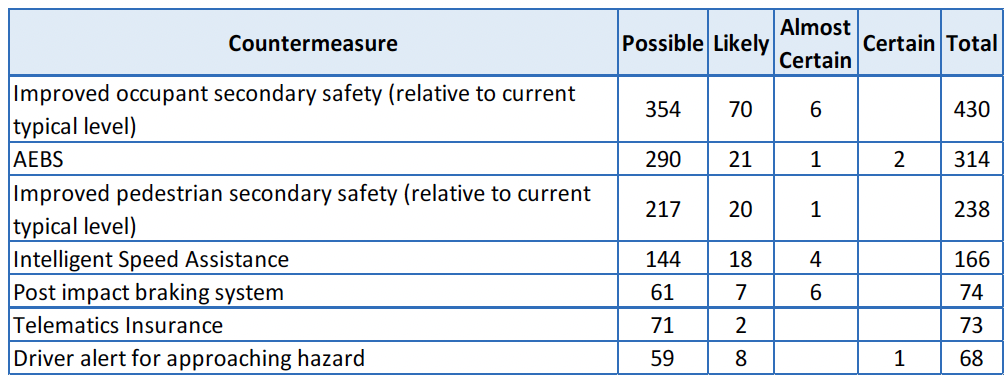
Road’ Countermeasures – Collision Avoidance
45% of Road CMs assigned for collision avoidance (n=457 of 1,013) were given a confidence score of 2 or more indicating that countermeasures in this group could be effective in preventing fatal collisions from occurring. This is despite the fact that only 18% of collisions were found to involve road related contributory factors.

Although ‘Reduce speed limit’ was the most frequently assigned measure, a confidence score of 1 was given in 92% of cases (n=329 of 359).
By contrast, ‘Add appropriate barrier’ was also applied frequently and in 48% of collisions (n=34 of 70) it was given a confidence score of 3 or 4 indicating that it is likely to be a more effective countermeasure.
Other CMs with high confidence scores were ‘Add cycle lane’; ‘Add pedestrian crossing (overpass or underpass)’; ‘Add traffic light control to junction’ and ‘Add roundabout’.
Road’ Countermeasures – Severity Reduction
Road CMs could be effective in reducing severity with 32% of those assigned given a confidence score of 2 or more (n=335 of 1,042).
Countermeasures relating to barriers and hazards would appear to be the most effective including ‘Add appropriate barrier’; ‘Remove hazard’; ‘Shield hazard with VRS/Improve type of VRS’ and ‘Higher containment level barrier’.

5.3 Vulnerable Road User Fatality Prevention
The following section show the CMs that were applied most frequently in relation to collision avoidance and severity reduction for collisions that resulted in a VRU fatality. In addition, countermeasures with a high confidence level have been highlighted.
A countermeasure may be attributed to the VRU or to another road user, vehicle or road factor that may have contributed to the collision.
Full lists of VRU related countermeasures can be found in Appendices G-I.
Pedestrians
In total, 1,808 countermeasures were applied to collisions resulting in a pedestrian fatality. ‘Vehicle’ CMs accounted for 41% (n=740) of all countermeasures assigned for pedestrian fatalities with particular focus on vehicular technologies such as ‘AEBS’, ‘Driver alert for approaching hazard’ and ‘Distraction monitoring’. This highlights the importance of the roll out of this technology in reducing pedestrian fatalities.
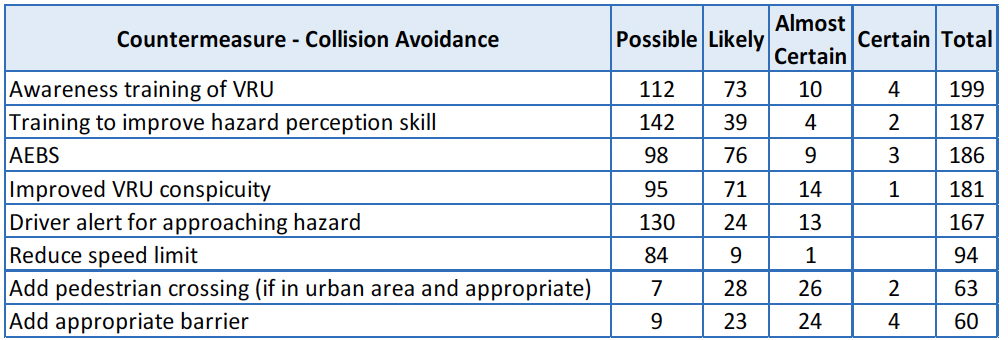
AEBS was made mandatory in all new HGVs from 2015 and it is hoped that similar regulations covering other vehicle types will be established in the UK in the near future[67].
87% (n=159 of 187) of ‘Training to improve hazard perception skill’ was assigned to drivers/riders indicating that there is a significant responsibility on drivers to be aware of the presence of pedestrians and the hazard they present. Nevertheless, ‘Awareness training of VRU’ and ‘VRU conspicuity’ were amongst the most frequently assigned countermeasures which shows that pedestrians themselves are pivotal in preventing fatalities. This includes taking measures such as wearing suitable, bright clothing during hours of darkness and crossing at appropriate places in the road.
‘Reduce speed limit’ was a countermeasure in 48% (n=104) of fatal collisions.
In many of these, a lower speed limit may have meant a driver who was travelling slower would have increased time and distance to stop in sufficient time to avoid the collision. 
A lower speed may also have resulted in less severe injuries and therefore not resulted in a fatality. Details of suggested speed limit reductions are provided in Appendix L.
The countermeasures with the highest confidence scores for Pedestrian fatality prevention were:
- Awareness training of VRU
- AEBS
- Add appropriate barrier.
Details of locations for the addition of an appropriate barrier are provided in Appendix O.
Motorcyclists
A total of 1,191 countermeasures were applied to collisions resulting in a motorcyclist fatality. The countermeasures applied most frequently and with the highest confidence ratings relate primarily to the behaviour of the motorcyclist.
73% (n=115 of 157) of ‘Training to improve hazard perception skill’ and 80% (n=67 of 84) of ‘Training or education to reduce risky driving manoeuvre’ was assigned to the motorcyclist indicating that the motorcyclist themselves must take responsibility for their driving style and behaviour.
Nevertheless, it is important that other drivers and road users are reminded of the need to be aware and mindful of motorcyclists.
Countermeasures relating to speed management, namely ‘Reduce speed limit’ and ‘Add speed camera at locus’ accounted for 50% of all ‘Road’ countermeasures assigned (n=121 of 239).This indicates that reducing the speed at which motorcycles can legally travel and ensuring riders stick to designated speed limits could have an impact on motorcyclist fatality numbers.

‘Anti-lock Braking System’ (ABS) for motorcycles accounted for 24% (n=94) of ‘Vehicle’ countermeasures indicating it could be an effective technology for reducing motorcyclist fatalities. These 94 collisions account for 59% of all fatal collisions resulting in the death of a motorcyclist.
ABS has been mandatory on all new motorcycles over 125cc since 2016. It is therefore hoped that the benefits of this technology amongst the fleet will be seen over coming years. (Recommendation 10)

The countermeasures with the highest confidence scores for motorcyclist fatality prevention were:
- Remove hazard
- Training or education to reduce risky driving manoeuvre
- Add speed camera at locus
- Better licensing (reduce exposure to specific high-risk situations).
Details of the suggested locations for the addition of a speed camera are provided in Appendix M
Pedal Cyclists
A total of 334 countermeasures were applied to collisions resulting in a pedal cyclist fatality. Overall, the confidence scores were lower than for other vulnerable road users.
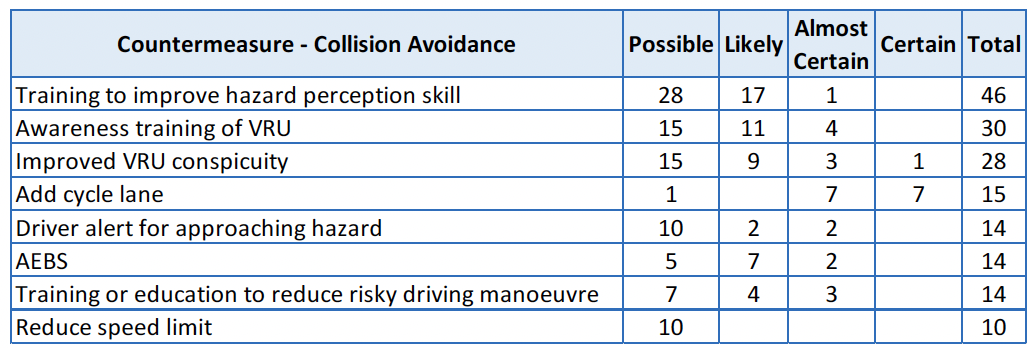
‘Training to improve hazard perception’ was the most frequently assigned countermeasure for pedal cycle fatalities, however more than half of these (59%, n=27 of 46) were assigned to other road users. This indicates that there is a need to improve awareness around pedal cyclists amongst other road users to ensure that they can share roads safely.
Countermeasures relating to the use of a helmet (‘Proper use of helmet’ and ‘Better helmet’) were applicable in 25 collisions, this represents 57% of all fatal pedal cycle collisions.
The addition of a cycle lane was a countermeasure in 36% (n=16) of pedal cyclist fatalities. These countermeasures will be discussed further, later in this report.

Countermeasures relating to ‘Vehicle’ were also noted including ‘AEBS’, ‘Driver alert for approaching hazard’ and ‘Distraction monitoring’ all of which relate to vehicles that share the road with cyclists. These were also noted to be the more common ‘Vehicle’ measures for pedestrian fatality reduction. Therefore, the introduction of these technologies to the fleet including mandatory fitment could be significant in preventing VRU fatalities.
The Countermeasures given the highest confidence scores were:
- Add cycle lane
- Add appropriate barrier.
Locations for the suggested addition of a cycle lane are provided in Appendix N. (Recommendation 14)
5.4 Countermeasure Application
By exploring the groups to which the most prevalent countermeasures were applied for fatal collisions, target populations can be identified for the most effective implementation of these countermeasures.
People’ Countermeasures
Training and education relate to:
- Training to improve hazard perception skill
- Training or education to reduce risky driving manoeuvre
- Training or education to reduce risky pre-driving behaviour (e.g., drink or drug use)
- Training or education to reduce other risky behaviours (e.g., wearing a seatbelt).
Although there is a separate overarching ‘Awareness training of VRU’ countermeasure (discussed below), the above countermeasures were also assigned to VRUs.
These two separate categories allow more ready identification where VRUs can be specifically targeted. It should also be noted that more than one of the above could be assigned per party involved in a collision.
For example, a driver who may have been impaired by alcohol and not wearing a seatbelt may be assigned both ‘Training or education to reduce risky pre-driving behaviour’ and ‘Training or education to reduce other risky behaviours’.
Analysis of the training and education countermeasures identifies they would be most beneficially targeted at younger car drivers, particularly males.
Those aged 16-25 accounted for 30% (n=217) of those assigned these countermeasures and those aged 26-35 a further 22% (n=162).
Males accounted for 82% (n=178) of those aged 16-25 and 87% (n=141) of those aged 26-35. (Recommendation 61)
18% (n=209) of training and education countermeasures were assigned to motorcyclists. This equates to 139 unique riders, 81% of all motorcycle riders involved in fatal collisions and highlights a possible need for improved training of motorcyclists.
Again, this countermeasure would be most effectively directed at younger male riders as those aged 16-25 accounted for 14% (n=29 of 209) and those aged 26-35 for 26% (n=55).
One female in the 16-25 age group was assigned a training CM, all others were male. (Recommendation 46)
Collisions resulting in a pedestrian fatality accounted for nearly a quarter of all fatal collisions where training or education was deemed to be an appropriate countermeasure (23%, 175 of 750 collisions).
However, training or education was only applied to pedestrians themselves in 3% (n=22) of collisions indicating improved training of drivers (particularly car drivers) could reduce pedestrian fatalities. (Recommendation 39)
Awareness Training of VRU
It was determined VRU awareness training merited a countermeasure of its own as VRUs account for a high number of fatalities. Therefore, although the overall training and education countermeasures discussed above may also be applicable to them, it is worthwhile exploring dedicated awareness training for VRUs.
Of the 18 child VRU fatalities, 16 (89%) were assigned this countermeasure highlighting that increased awareness raising of children – particularly as pedestrians and pedal cyclists – would be beneficial.
More than a quarter of pedestrians to whom this measure was applied were aged over 76. This may also highlight a need for awareness raising amongst older members of the population.
Around half (48%, 95 of 197) of all pedestrians assigned this CM had home postcodes in the more socially deprived[68] areas of Scotland compared with 28% (n=56) from the least deprived areas[69].
For child pedestrians, 72% (n=8 of 11) had home postcodes in the most deprived areas and only 9% (n=1 of 11) in the least deprived areas. (Recommendation 19)
Better Licensing (Medical/Health)
This measure was applied primarily to collisions when a driver/rider medical episode had been suspected and those where defective eyesight was detected. More than half of those it was applied to were over 65 (51%, n=53 of 103), with 31% being over 76 (n=32 of 103). This indicates that improving licensing schemes for older drivers, including the introduction of mandatory cognitive assessments and eyesight tests could have a positive impact on fatality figures.
It will not be possible to test for nor prevent medical episodes amongst drivers of any age, however, arguably more could be done to assess fitness to drive amongst older drivers.
This countermeasure was also applied to two collisions considered as possible suicides. In both instances, the driver was known to be suffering with mental health problems. Fatal collisions with such characteristics are referred to the Partnerships, Prevention and Community Wellbeing (PPCW) Division where the skills and contributions of partners are used to deliver guidance and advice. This whole system approach uses a public health ethos to tackle the complexities and issues faced by those most in need of services[70]. (Recommendation 25)
Use Of Seatbelt
Seatbelt wearing is known to be a very effective way of preventing fatalities.
107 fatalities were not wearing a seatbelt.
The use of a seatbelt was identified as a suitable countermeasure and may have resulted in a different outcome for 102 (94%) fatalities.
It is important to ensure that all vehicle occupants, where required to wear a restraint do so while making sure these are correctly fitted and properly secured.
As highlighted earlier, not wearing a seatbelt was most common amongst those aged 16-25. Therefore, unsurprisingly, this is the age group to which this countermeasure was most frequently applied. (Recommendation 4)
Use of seatbelt was most frequently applied to car occupants, however, a number of bus/coach occupants were also noted. 9 bus passengers were fatally injured, 6 of whom would have been required to wear seatbelts but were not.
This highlights a need to increase seatbelt wearing rates amongst bus passengers. These collisions occurred across the East and West of Scotland. (Recommendations 1, 38)
Enforcement of seatbelt wearing on buses is difficult as passengers are only required to wear belts when a bus or coach is moving. This means officers cannot pull over vehicles for spot checks and would have to travel on vehicles to be able to issue fines. Therefore, the focus must be on raising awareness of both the law and benefits of seatbelt wearing on these modes of transport.
Proper Use Of Helmet
‘Proper use of helmet’ was applied to pedal cyclists, motorcyclists and quad bike riders.
For pedal cyclists, the countermeasure was applied to all riders who had not been wearing a helmet indicating it could be an effective measure in reducing the severity of injuries. This was targeted primarily at older cyclists with 50% (n=9 of 18) being over the age of 56 (2 aged 56-65, 7 aged over 65).
Proper use of a helmet was identified as a countermeasure for all cyclists aged under 16. Therefore, helmet usage amongst children should be encouraged.
As The Child Safety (Cycle Helmets) Bill 2020 continues to be progressed through parliament, it may become mandatory for child cyclists to wear safety helmets.
As has been highlighted previously in this report, there are arguments that mandatory helmet requirements do not improve cyclist safety and instead suitable infrastructure is required.
Nevertheless, until Scotland’s roads are improved for cyclists, helmet wearing should be encouraged as it has been identified as a potentially effective countermeasure. (Recommendations 12, 13)
Only 5 of the 161 (3%) motorcyclist fatalities were found not to be wearing a helmet. However, the countermeasure of ‘proper use of helmet’ was applied to 10 motorcyclists. For the 5 riders assigned this measure who had been wearing helmets, their helmets had come off following impact and there was indication or assessment that these had not been secured correctly or at all.
Therefore, there is a need for motorcyclists to ensure that helmets are fitted and secured properly. (Recommendation 30)
‘Vehicle’ Countermeasures
‘Vehicle’ countermeasures have been highlighted throughout this report as significant in reducing road fatalities.
It must be noted at this stage the following analysis focusses on countermeasures relative to fatal collisions, as and when they occurred.
Vehicle technology is an ever changing and advancing field. Therefore, vehicle features and systems may have been identified as countermeasures for some collisions may now be standard and/or mandatory in vehicles today. Nevertheless, this will hopefully highlight the importance of these technologies and encourage uptake and fitment.
The technologies and safety systems discussed in this section of the report became compulsory in all new vehicles manufactured and sold across the EU from July 2022[71] under the EU’s Vehicle General Safety Regulation[72].
This recognises the increased road safety benefits brought by these technologies which the UK’s Transport Research Laboratory believe could potentially have a greater safety benefit than the introduction of seatbelts[73].
Following EU-exit, the UK Government has not yet decided whether they will adopt the same standards for new vehicles manufactured in this country. (Recommendation 56)
Improved Occupant Secondary Safety
‘Secondary safety’ refers to vehicle features that come into play once a collision has occurred and are designed to reduce injury to the occupants. This covers seatbelts and airbags, head restraints and the design of the bodyshell and vehicle interior.
‘Improved occupant secondary safety’ was applied as a countermeasure when it was deemed improvements in vehicle design or performance could have had a positive influence on the outcome.
This includes collisions where internal safety features have not performed as expected or where an increase in their presence may have been beneficial.
This countermeasure was applied primarily to cars, however, was also noted to be relevant to HGVs.
10 HGV drivers were killed during the reporting period. Improved occupant secondary safety was assigned as a possible countermeasure for 90% of these fatalities.
This indicates there may be improvements which could be made to the design of HGV cabs to make them safer for HGV drivers and occupants.
HGVs have limited crumple zones[74] and a cuboid cab design[75] which can result in fatal injuries to HGV drivers as they are afforded little physical protection by the vehicle bodyshell. This will be most relevant for collisions involving HGVs with other HGVs or large vehicles, or collisions with objects and hazards such as trees.
Improved occupant secondary safety may be more effective at preventing younger fatalities. 58% of all fatalities aged 16-25 were applied this measure (n=87 of 149) as were 58% of those aged 26-35 (n=79 of 137).
This is compared with 38% of fatalities aged 76-85 (n=48 of 110) and 41% of those aged 86 and over (n=18 of 43).
Collisions involving younger drivers/fatalities may be more likely to involve higher speeds and, therefore, more forceful impact where the presence of fully-functioning secondary safety systems could make a difference.
The Scottish Government has recently launched the new Mobility and Scrappage Fund – offering cash incentives and Travel Better vouchers for households removing older, more polluting cars from the roads. Although this pilot project has a largely environmental focus, it may also have a positive impact on road safety by encouraging drivers to remove older vehicles from the road which have less advanced secondary safety systems. (Recommendation 57)
Advanced Emergency Braking System (AEBS)
AEBS monitors the road ahead of a vehicle and activates the brakes when a potential collision is detected. This in turn assists in reducing the speed of a vehicle, meaning a collision may occur at a lesser speed or be avoided altogether.
AEBS could play a significant role in reducing pedestrian fatalities.
82% of collisions resulting in a pedestrian fatality has AEBS applied as a countermeasure (n=186 of 226).
AEBS was relevant primarily for cars, however, it was also applied to a large number of vans, Light Goods Vehicles (LGVs),Heavy Goods Vehicles (HGVs) and buses/coaches. AEBS has been mandatory in new HGVs since 2015 and the technology has been found to be highly effective in preventing collisions or reducing the severity of a crash[76].
The benefits realised by the mandatory implementation of this technology to HGVs is likely to be replicated across all other vehicle types.
Distraction Monitoring
Distraction monitoring systems monitor the movements of a vehicle to ensure it is being driven in a controlled manner. When risky driving behaviour is detected the driver is alerted through audio and/or visual alerts. This may encourage drivers to alter their behaviour, thus reducing the risk of a collision occurring.
This technology was assigned as a potential countermeasure 304 times over 303 collisions.
It would be most beneficial for younger drivers with those aged 16-25 accounting for 21% (n=64) of instances where this measure was applied. This is compared with 6% (n=17) for those aged 76-85 and just 2% (n=7) for those over 86.
While it was relevant primarily for cars, larger vehicles including vans/LGVs, HGVs and buses/coaches would also benefit from having this technology installed.
Intelligent Speed Assistance
Intelligent Speed Assistance (ISA) uses speed-recognition and/or GPS linked speed limit data to advise drivers of the current speed limit and automatically limits the speed of a vehicle as needed.
ISA systems do not automatically apply the brakes but simply limit engine power preventing the vehicle from accelerating past the current speed limit unless overridden.
ISA on new vehicles is already relatively common, helped in part by Euro NCAP’s decision to reward extra points for vehicles that include ISA[77].
Under the EUs Vehicle General Safety Regulation, over-rideable ISA systems are mandatory on all new cars sold in the EU from 2022.
This countermeasure was applied primarily to cars but was also noted to be relevant to motorcycles.
This measure is identified as being potentially significant in tackling the issue of young male drivers exceeding the speed limit. It was applied significantly more to younger drivers with 36% aged 16-25 (n=65 of 182) and 31% 26-35 (n=56). The overwhelming majority (94%, n=170) were males.
ISA would be effective for collisions on roads with higher speed limits as more than half (54%, n=98) of collisions in which it was identified as countermeasure had occurred on 60mph roads. However, more than a fifth (21%, n=38) had occurred on 30mph roads. 45% (n=17) of these collisions had resulted in a pedestrian fatality.
Therefore, ISA could be effective in preventing collisions that occur at lower speeds and have a positive impact on VRU fatality numbers.
Alco-Lock[78]
Alco-lock devices have been identified through this study as being a highly-effective countermeasure where impairment by alcohol was a contributory factor. Under the EU’s Vehicle General Safety Regulation, all new cars from 2022 will be enabled to have an Alco-lock device installed. However, this does not make it mandatory for a device to be installed.
This countermeasure would be most effective at tackling collisions involving young male drivers.
Those aged 26-35 accounted for 38% (n=23 of 68) of those the measure was applicable to, and drivers aged 16-25 a further 32% (n=20). 90% (n=60) of these drivers were male. (Recommendations 59, 60)
‘Road’ Countermeasures
Reduce Speed Limit - A reduction in the speed limit may mean collisions can be avoided entirely by allowing drivers more time to react to hazards or may mean injury severity is reduced if a collision occurs at a lesser speed.
The specific roads this measure was applied to most frequently were the A82 (n=25) and the A9 (n=21). These roads cover large geographic areas from Glasgow to Inverness and Falkirk to Thurso respectively.
Further analysis was undertaken of these roads which identified a reduction in the speed limit was assigned as a suitable countermeasure for a number of separate clusters of collisions that occurred in close proximity to one another[79].
On the A82, the highlighted collisions which occurred on Great Western Road occurred within 50mph limits; the remaining highlighted collisions occurred on 60mph roads.
On the A9, collisions occurred on 60mph roads.
The Great Western Road collisions all resulted in either a pedestrian or pedal cyclist fatality due to the close proximity of these VRUs and fast-moving traffic.
50% (n=3) of the fatal collisions that occurred on the A82 between Tarbet and Arden (approximately 14 miles apart) resulted in a motorcyclist fatality. The reduction of the speed limit in these areas, therefore, may have a positive impact on motorcyclist fatality numbers. (Recommendation 66)
It should be noted that in only one of the highlighted collisions on the A82, was a driver, deemed by Collision Investigation, to be exceeding the speed limit. A third of the highlighted collisions on the A9 (n=2) were due in part to a driver ‘Exceeding the speed limit’ or ‘travelling too fast for conditions’.
This highlights the majority of these fatal collisions occurred while vehicles were travelling at or within the posted speed limit and as such a speed limit reduction may be beneficial.
Any speed limit reduction on the A9 must be considered alongside the ongoing A9 Perth to Inverness dualling programme.
Add Speed Camera At Locus
The roads which this measure was applied to most frequently were the A9 (n=6), followed by the A82, A92, and A93 (n=5 each).
63% of the roads it was applied to had a posted speed limit of 60mph. This measure was deemed to be appropriate for 83% of collisions where ‘Exceeding a speed limit’ was a contributory factor. This provides an example of a ‘People’ CF that could be effectively targeted by a ‘Road’ countermeasure.
The locations where the addition of a speed camera was assigned the highest confidence scores are shown in Map 8[80].
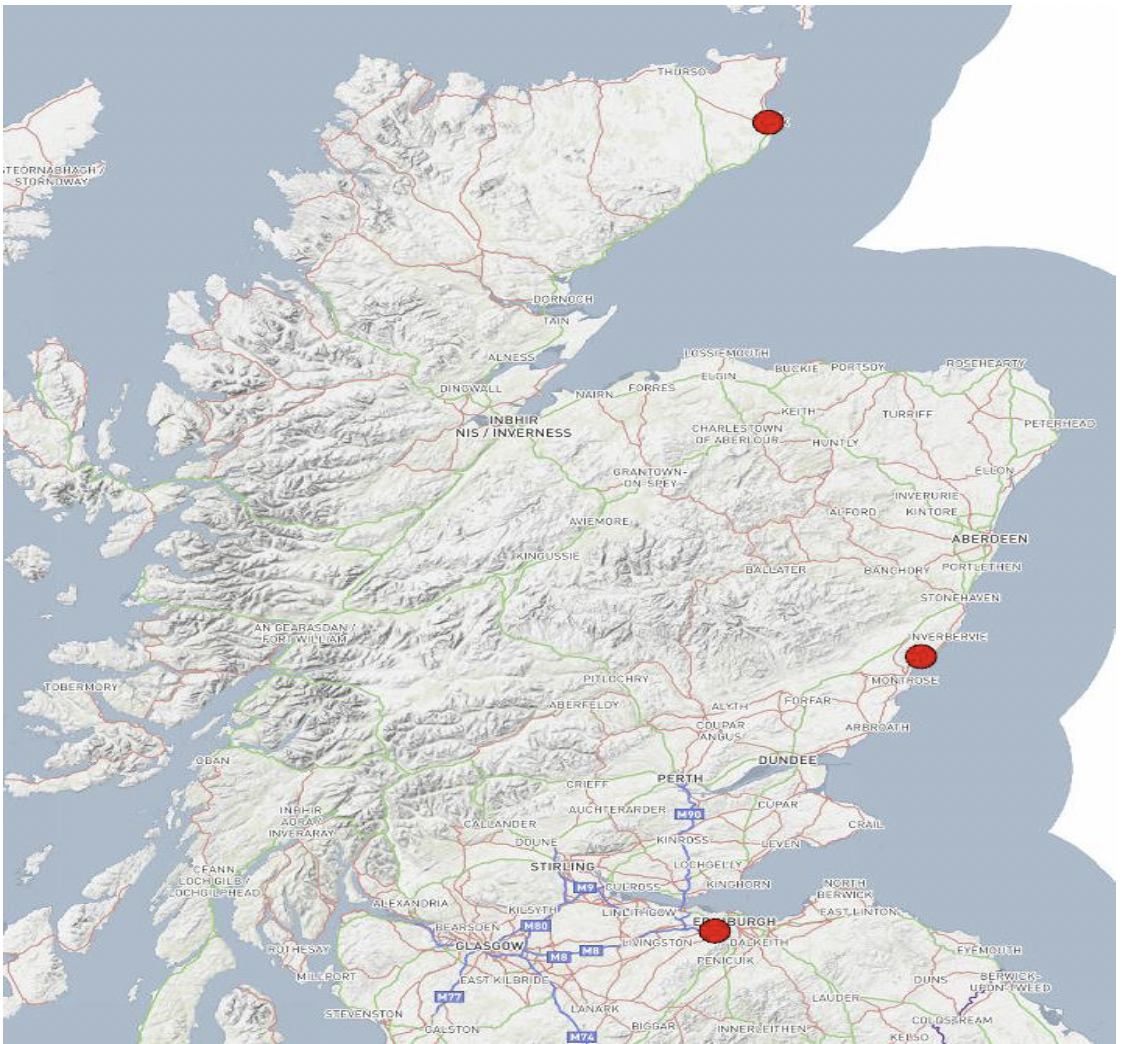
A speed camera was assessed as being highly likely to have had an impact on collision occurrence and/or injury severity in these instances.
The Scottish Safety Camera Programme Handbook[81] highlights that camera enforcement resources must be prioritised at sites with the potential for maximum casualty reduction.
Prior to the installation of a camera, collision data over the most recent five-year period should be assessed and must only include collisions in the direction of proposed enforcement. Based on this data, a points-based system is used to decide if a site can be considered for this enforcement.
Add Cycle Lane
The addition of a cycle lane scored very highly for collision avoidance. 88% (n=14 of 16) of collisions to which it was applied were given a confidence score of 3 or 4 (almost certain or certain).
It was a recommended countermeasure in more than a third (36%, n=16 of 44) of collisions which resulted in a pedal cyclist fatality.
Recent years have seen an increase in pedal cyclists, both for leisure and everyday journeys[82]. This is due to a number of factors including the Covid-19 pandemic, an increased interest in and awareness of environmental and sustainability issues and the desire for a more active lifestyle. A need for suitable, high-quality infrastructure for cyclists – including dedicated cycle lanes – is crucial[83] to ensure the safety of cyclists.
Map 9 indicates where the addition of a cycle lane is recommended[84]. It should be noted, these locations were highlighted in response to where pedal cyclist fatalities have already occurred and consideration has not been given to the real time practicalities of implementing cycle lanes in these places.
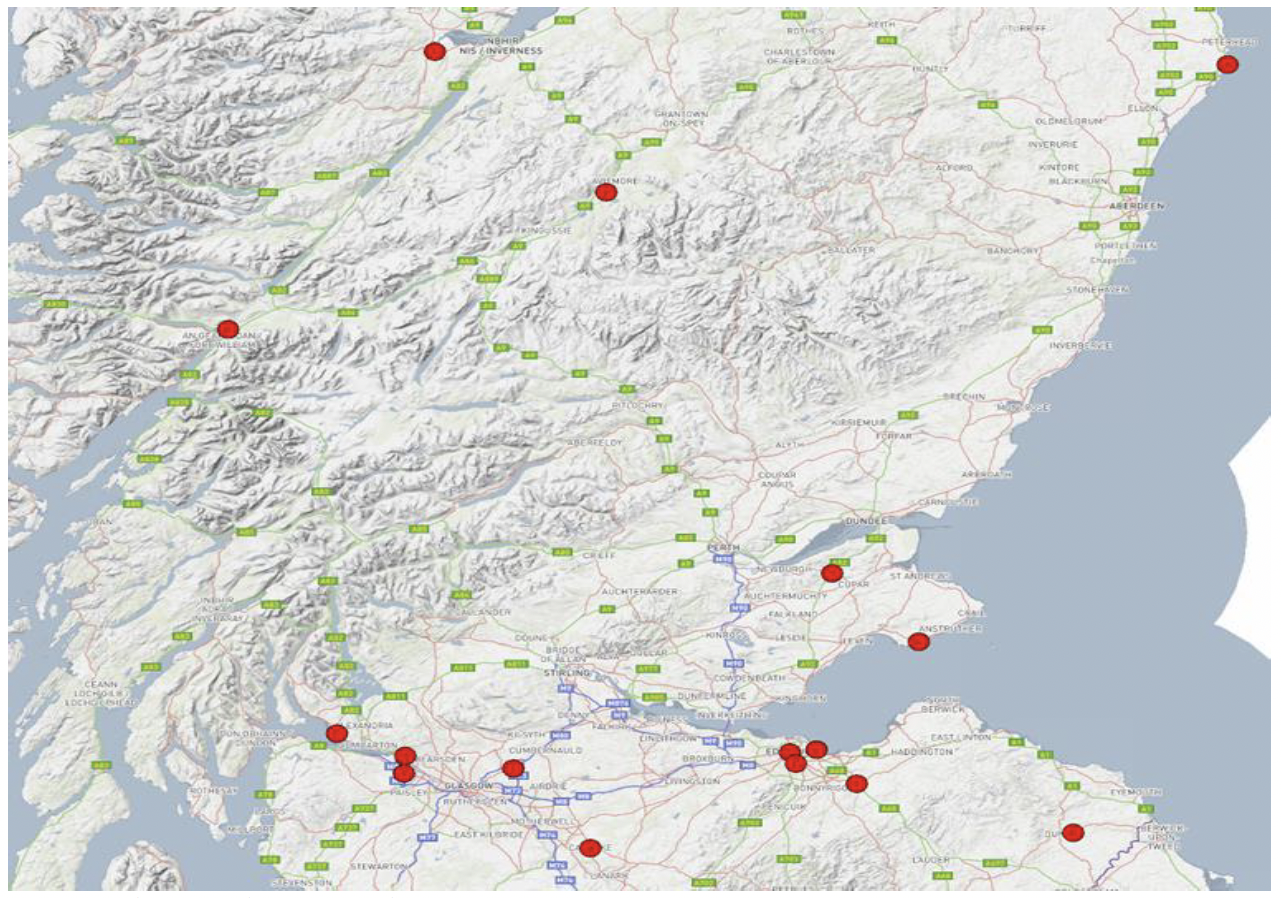
They are however worth noting as they indicate locations where vehicular traffic and cyclists have come into contact and highlight the significant difference a dedicated cycle lane could have made. (Recommendation 68)
75% (n=12 of 16) of the identified locations are roads with a 50mph or 60mph posted speed limit indicating that cycle lanes are likely to be most effective and necessary on roads where pedal cyclists are in close proximity to vehicles travelling at higher speeds.
The drive to introduce safer, more suitable infrastructure for pedal cyclists including the addition of cycle lanes must continue, as it is recognised as a potentially highly-effective countermeasure for pedal cyclist fatalities.
Until suitable infrastructure is in place, other measures to protect cyclists require to be utilised. These include encouraging other road users to be cognisant of pedal cyclists, and campaigns to highlight the importance of helmet wearing.
Add Appropriate Barrier
A number of different kinds of barriers are available such as wire-rope safety barriers and concrete barriers. Different barriers will be more suitable for some locations but unsuitable for others.
Barriers have proved to be an effective measure in road safety and provided they are properly installed and adequately maintained they can reduce severe collision outcomes by up to 80%[85]. More than a quarter (29%, n=66 of 227) of fatal collisions assigned this countermeasure involved a pedestrian fatality.
In these instances it is possible the addition of a barrier would have prevented the pedestrian from being able to enter the road thus, potentially, preventing them from coming into contact with a vehicle.
On a number of other occasions, a driver has lost control and mounted the pavement where the vehicle has struck pedestrians. The presence of a barrier may have provided the pedestrians with some protection.
The addition of a barrier was also found to be a suitable countermeasure for 6 pedal cyclist fatalities and 12 motorcyclist fatalities indicating this countermeasure could be effective in preventing VRU fatalities.
The majority of collisions however related to vehicles that had lost control – either on a straight road or on a bend. Many of these vehicles had subsequently left the road and collided with a hazard, including trees, walls and fences.
The presence of a roadside barrier may have prevented the vehicle from leaving the road and/or hitting a hazard.
Other vehicles have lost control and crossed over into the opposing carriageway. The presence of a central reservation barrier may have prevented this. (Recommendation 67)
Collisions where addition of a barrier would have prevented a vehicle from leaving the road and colliding with a tree are depicted in Map 10[86].
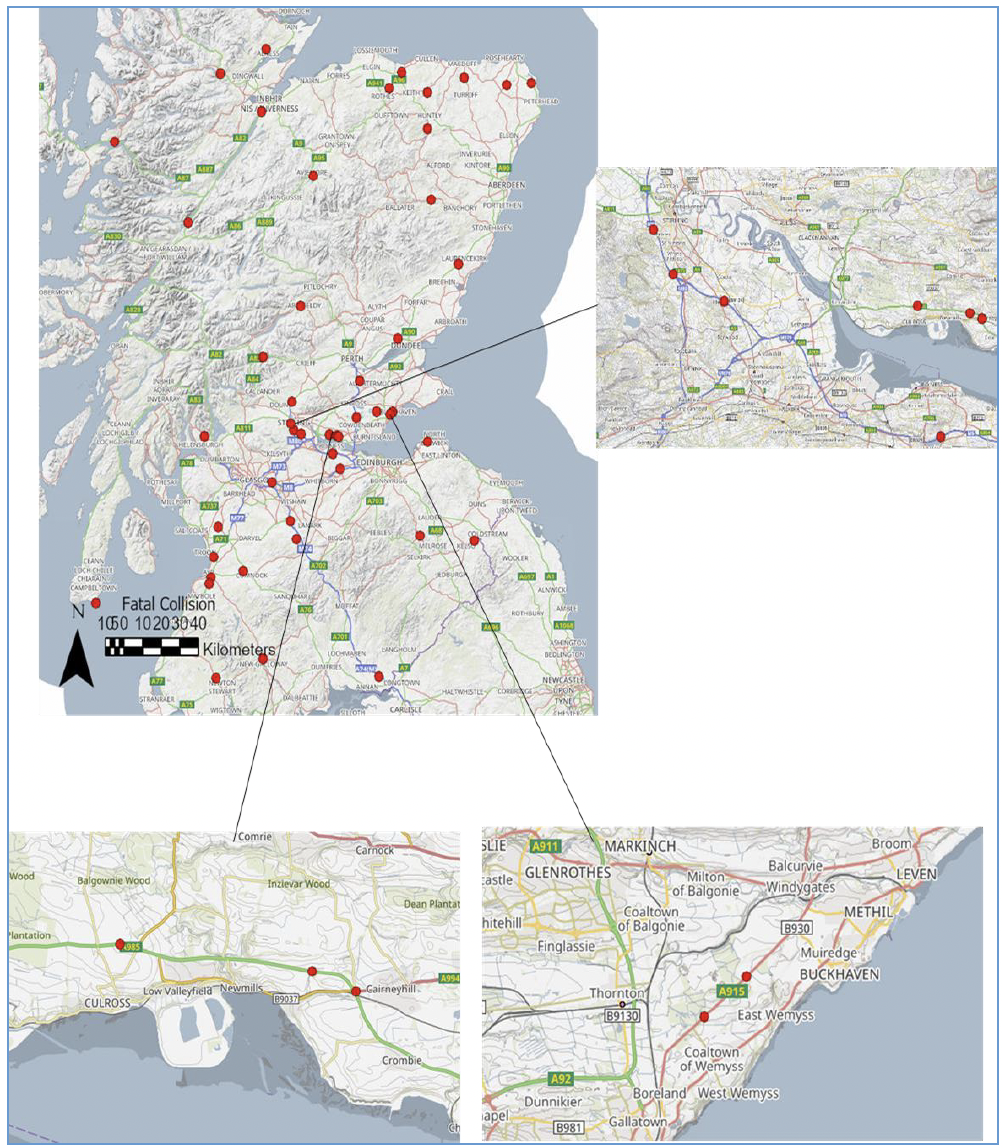
Of note, 4 (10%) of these collisions were on the M9. This map also identifies collisions with similar characteristics that occurred on both the A915 (on a stretch known as the Standing Stane Road) and the A985. This countermeasure was applied to the A82 most frequently as per Map 11 (below).
The addition of an appropriate barrier was assigned as a countermeasure for two collisions on a roughly 5 mile stretch of road between Fort William and just north of Torlundy, and for three collisions on a roughly 15 mile stretch between Glencoe and Bridge of Orchy.
It was also a measure for two collisions on the Great Western Road section of the A82, both of which resulted in a pedestrian fatality.
